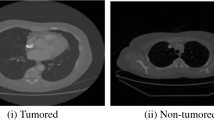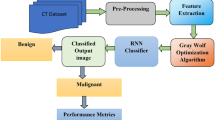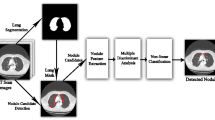Abstract
Lung cancer is the leading cause of death from cancer worldwide. Finding pulmonary nodules is a critical step in the diagnosis of early-stage lung cancer. It has the potential to become a tumour. Computed tomography (CT) scans for lung disease analysis offer useful data. Finding malignant pulmonary nodules and determining whether lung cancer is benign or malignant are the main goals. Before further image preparation, image denoising is an important process for removing noise from images (feature extraction, segmentation, surface detection, and so on) maximising the preservation of edges and other intact features. This study employs a novel evolutionary method dubbed the binary grasshopper optimisation algorithm in order to address some of the shortcomings of feature selection and provide an efficient feature selection algorithm, the artificial bee colony (BGOA-ABC) algorithm enhance categorisation. Then, to categorise the chosen features, we employ a hybrid classifier known as a double deep neural network (DDNN) algorithm. A technique used by MATLAB that segments impacted areas utilising improved IPCT (Profuse) aggregation technology employing datasets from the cancer image archive (CIA), the image database resource initiative (IDRI), and the lung imaging database consortium. Various performance metrics are evaluated and associated with different cutting-edge techniques, classifiers that are already in use.





Similar content being viewed by others
Availability of Data and Materials
Data sharing is not applicable to this article as no datasets were generated or analysed during the current study.
Abbreviations
- CT:
-
Computed tomography
- BGOA-ABC:
-
Binary grasshopper optimisation algorithm artificial bee colony
- CIA:
-
Cancer image archive
- LIDC-IDRI:
-
Lung imaging database consortium, and the image database resource initiative
- MRI:
-
Magnetic resonance imaging
- M-CNN:
-
Multilayer convolutional neural network
- CAD:
-
Computer-aided diagnostic
- MRT:
-
Mean residence time
- CMM:
-
Continuous Markov models
- MLE:
-
Maximum likelihood estimation
- RGB:
-
Red–green–blue
- NLM:
-
Non-local mean
- ANLM:
-
Adaptive nonlocal means
- DDNN:
-
Double deep neural network
- MSE:
-
Mean square error
- PSNR:
-
Peak signal-to-noise ratio
References
M. Palaniappan, M. Annamalai. Advances in signal and image processing in biomedical applications. (2019). https://doi.org/10.5772/intechopen.88759
S. Kolli, V. Praveen, J. Ashok, A. Manikandan. Internet of things for pervasive and personalized healthcare: architecture, technologies, components, applications, and prototype development. (2023). https://doi.org/10.4018/978-1-6684-8913-0.ch008
T. Guo, J. Dong, H. Li, Simple convolutional neural network on image classification. In Proceedings of the 2nd International Conference ICBDA, Beijing, China, 10–12 March 2017.
A. Ivanov, A. Zhilenkov, The prospects of use of deep learning neural networks in problems of dynamicimages recognition. In Proceedings of the EIConRus, Moscow, Russia, 29 January–1 February 2018.
H.P. Chan, L.M. Hadjiiski, R.K. Samala, Computer-aided diagnosis in the era of deep learning. Med. Phys. 47(5), e218–e227 (2020)
A.R. Venmathi, S. David, E. Govinda, K. Ganapriya, R. Dhanapal and A. Manikandan, An automatic brain tumors detection and classification using deep convolutional neural network with VGG-19. in 2nd International Conference on Advancements in Electrical, Electronics, Communication, Computing and Automation (ICAECA), Coimbatore, India, 2023, pp 1–5 (2023). https://doi.org/10.1109/ICAECA56562.2023.10200949
L. Ficsor, V.S. Varga, A. Tagscherer, Z. Tulassay, B. Molnar, Automated classification of inflammation in colon histological sections based on digital microscopy and advanced image analysis. Cytometry A 73A(3), 230–237 (2008)
Y. LeCun, Y. Bengio, G. Hinton, Deep learning. Nature 521(7553), 436–444 (2015)
M. Anthimopoulos, S. Christodoulidis, L. Ebner, A. Christe, S. Mougiakakou, Lung pattern classification for interstitiallung diseases using a deep convolutional neuralnetwork. IEEE Trans. Med. Imaging 35(5), 1207–1216 (2016)
S. Kolli, M. Ranjani, P. Kavitha, D.A.P. Daniel and A. Chandramauli, Prediction of water quality parameters by IoT and machine learning. in 2023 International Conference on Computer Communication and Informatics (ICCCI), Coimbatore, India, 2023, pp. 1–5, https://doi.org/10.1109/ICCCI56745.2023.10128475
H. Yu, Z. Zhou, Q. Wang, Deep learning assisted predict of lung cancer on computed tomography images using the adaptive hierarchical heuristic mathematical model (2020) [online]. Available: https://doi.org/10.1109/ACCESS.2020.2992645
K. Bommaraju, A. Manikandan, S. Ramalingam. Aided system for visually impaired people in bus transport using intel galileo Gen-2: Technical note. International Journal of Vehicle Structures and Systems, 9(2), 110–112 (2017). https://doi.org/10.4273/ijvss.9.2.09
S. Kolli, M. Hasan, B. Hazela, A. A. J. Pazhani, Secure the smart grid by machine learning. in International Conference on Computer Communication and Informatics (ICCCI), Coimbatore, India, 2023, pp. 1–4, https://doi.org/10.1109/ICCCI56745.2023.10128269
K. Srinivas, J. Aswini, P. Patro, D. Kumar, Functional overview of integration of AIML with 5G and beyond the network, in International Conference on Computer Communication and Informatics (ICCCI), Coimbatore, India, 2023, pp. 1–5, https://doi.org/10.1109/ICCCI56745.2023.10128466
M. Sandler, A. Howard, M. Zhu, A. Zhmoginov, L.C. Chen, Mobilenetv2: inverted residuals and linear bottlenecks. in Proceedings of the IEEE Conference on Computer Vision and Pattern Recognition, 2018, pp. 4510–4520
S.G. Armato III., G. McLennan, L. Bidaut, M.F. McNitt-Gray, C.R. Meyer, A.P. Reeves et al., The lung image database consortium (LIDC) and image database resource initiative (IDRI): a completed reference database of lung nodules on CT scans. Med. Phys. 38(2), 915–931 (2011)
A. Asuntha, A. Srinivasan. Deep learning for lung Cancer detection and classification. Multimedia Tools and Applications 1–32 (2020)
X.Z. Zhao, L.Y. Liu, S.L. Qi, Y.Y. Teng, J.H. Li, W. Qian. Agile convolutional neural network for pulmonary nodule classification using CT images. International Journal of Computer Assisted Radiology and Surgery 13, 585–595 (2018)
X.L. Liu, F. Hou, A. Hao. Multi-view multi-scale CNNs for lung nodule type classification from CT images. Pattern Recognition 77, 262–275 (2018)
D. Kumar, A. Wong, D.A. Clausi. Lung nodule classification using deep features in CT images. in Proceedings of the 2015 12th Conference on Computer and Robot Vision (CRV), Halifax, NS, Canada, 3–5 June 2015, pp. 133–138
W. Shen, M. Zhou, F. Yang, C.Y. Yang, J. Tian. Multi-scale convolutional neural networks for lung nodule classification. in information processing in medical imaging (Springer, Cham, Switzerland, 2015) pp 588–599
Y. Xie, J. Zhang, Y. Xia, Semi-supervised adversarial model for benign–malignant lung nodule classification on chest CT. Medical Image Analysis 57, 237–248 (2019)
S.R. Sannasi Chakravarthy, H. Rajaguru. Lung cancer detection using probabilistic neural network with modified crow-search algorithm. Asian Pacific Journal of Cancer Prevention 20(7), 2159 (2019)
S. Kolli, A.P. Krishna, M. Sreedevi. A meta heuristic multi-view data analysis over unconditional labeled material: An intelligence OCMHAMCV: Multi-view data analysis. Scalable Computing: Practice and Experience 23(4), 275–289 (2022)
S. Kolli, M. Sreedevi. Adaptive clustering approach to handle multi similarity index for uncertain categorical data streams. Journal of Advanced Research in Dynamical and Control Systems 10(04) (2018)
R. Ali, A. Manikandan, J. Xu. A novel framework of adaptive fuzzy-GLCM segmentation and fuzzy with capsules network (F-CapsNet) classification. Neural Computing and Applications (2023). https://doi.org/10.1007/s00521-023-08666-y
M. Annamalai, P. Muthiah. An early prediction of tumor in heart by cardiac masses classification in echocardiogram images using robust back propagation neural network classifier. Brazilian Archives of Biology and Technology 65. (2022). https://doi.org/10.1590/1678-4324-2022210316
A. Manikandan, M. Ponni Bala, Intracardiac mass detection and classification using double convolutional neural network classifier. Journal of Engineering Research 11(2A), 272–280. (2023). https://doi.org/10.36909/jer.12237
D. Balamurugan, S.S. Aravinth, P. Reddy, A. Rupani, A. Manikandan. Multiview objects recognition using deep learning-based wrap-CNN with voting scheme. Neural Processing Letters 54, 1–27 (2022). https://doi.org/10.1007/s11063-021-10679-4
A. Manikandan. A survey on classification of medical images using deep learning. Journal of Image Processing and Intelligent Remote Sensing (JIPIRS) 1(01), 5–14. (2021). https://doi.org/10.55529/jipirs.11.5.14
Acknowledgements
Not applicable.
Funding
No funding was received by any government or private concern. “No funding was obtained for this study”.
Author information
Authors and Affiliations
Corresponding author
Ethics declarations
Conflict of interest
The authors declare that they have no competing interests.
Additional information
Publisher's Note
Springer Nature remains neutral with regard to jurisdictional claims in published maps and institutional affiliations.
Rights and permissions
Springer Nature or its licensor (e.g. a society or other partner) holds exclusive rights to this article under a publishing agreement with the author(s) or other rightsholder(s); author self-archiving of the accepted manuscript version of this article is solely governed by the terms of such publishing agreement and applicable law.
About this article
Cite this article
Kolli, S., Parvathala, B.R. A Novel Assessment of Lung Cancer Classification System Using Binary Grasshopper with Artificial Bee Optimisation Algorithm with Double Deep Neural Network Classifier. J. Inst. Eng. India Ser. B (2024). https://doi.org/10.1007/s40031-024-01027-w
Received:
Accepted:
Published:
DOI: https://doi.org/10.1007/s40031-024-01027-w




